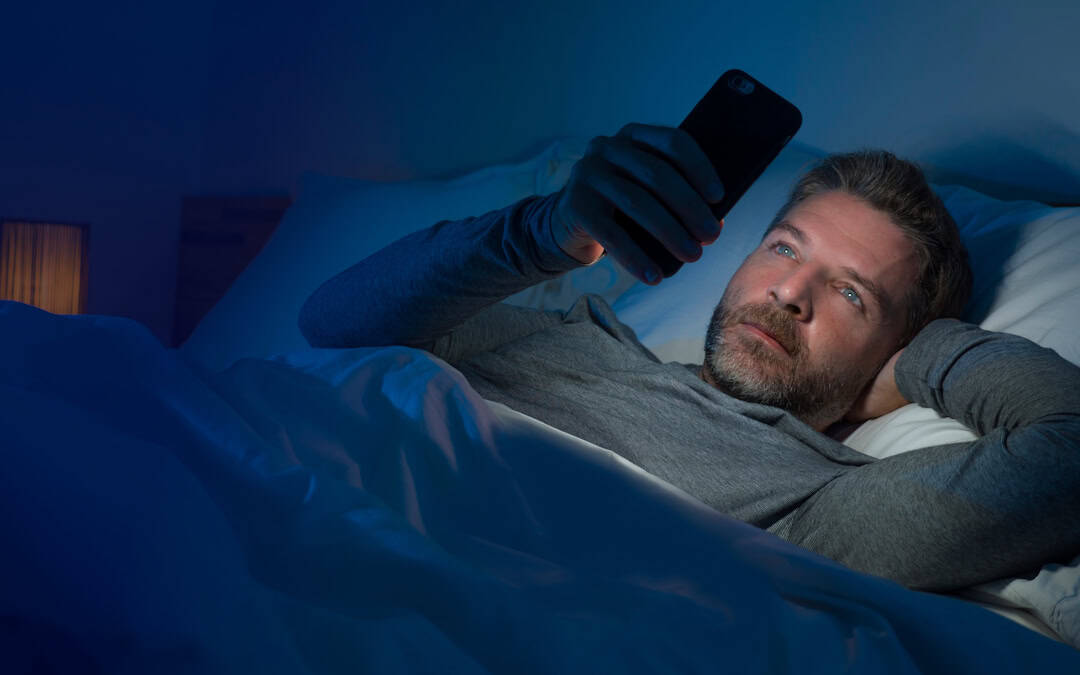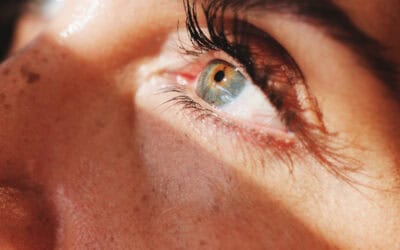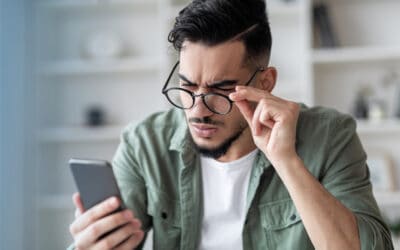Your daily screen exposure has reached levels unprecedented in human history. During COVID-19 lockdowns, nearly a third of people used blue-light-emitting devices 9 to 11 hours per day. Another 15% pushed their usage even higher with 12 to 14 hours of daily screen time. These numbers represent a dramatic shift in how much artificial blue light reaches your eyes every single day.
Digital eyestrain now affects approximately 50% of computer users.
Digital eyestrain now affects approximately 50% of computer users. You might recognize the symptoms: tired eyes after long work sessions, headaches from staring at your phone, or that gritty feeling after hours of screen time. These immediate effects raise a more serious question: does prolonged blue light exposure cause lasting damage to your vision?
Some research suggests a connection between blue light exposure and age-related macular degeneration (AMD), the leading cause of vision loss in Americans over 50. Children face potentially greater risks since their eyes absorb more blue light from digital screens than adult eyes do.
The relationship between blue light and your eye health isn’t straightforward. Early research indicates that insufficient blue light exposure might actually contribute to rising nearsightedness rates. Spending just one hour outside on an overcast day exposes your eyes to 30 times more blue light than sitting in front of a screen for the same duration.
Your eyes encounter blue light from both natural and artificial sources daily, making it essential to understand when this exposure helps and when it might harm. The team at Chang Eye Group in Pittsburgh has written this guide to explore the science behind blue light, its effects on your vision and sleep, and practical steps you can take to protect your eye health while still benefiting from the screens you rely on.
Understanding Blue Light: Sources and Science
The visible light spectrum occupies just a tiny slice of the electromagnetic radiation surrounding us every day. Human eyes detect only wavelengths between approximately 380 to 700 nanometers (nm) which is a very narrow window of the vast electromagnetic spectrum.
The science behind what your eyes see
Sunlight passing through a prism reveals the familiar rainbow of colors, each corresponding to a specific wavelength. Violet light carries the shortest wavelength at around 380 nm, while red light stretches to approximately 700 nm. Blue light occupies the 380 to 500 nm range on this spectrum.
Scientists further divide blue light into two distinct categories: higher energy blue-violet light (380-450 nm) and lower energy blue-turquoise light (450-500 nm). This distinction matters because the energy level directly affects how blue light interacts with your eye tissues.
Where blue light comes from
Our daily exposure to blue light comes primarily from the sun. The sun produces 24-30% blue light on average, though this intensity changes dramatically throughout the day. Solar blue light peaks at noon when the sun sits directly overhead, then diminishes significantly at sunrise and sunset.
Artificial sources also contribute substantial blue light exposure to your daily routine. Every smartphone screen, tablet, laptop, and flat-screen television emits blue light. LED and fluorescent lighting systems also produce considerable amounts. Most LED technology creates white light by pairing blue LEDs with yellow phosphor, resulting in illumination that peaks in the blue spectrum.
Why blue light behaves differently
There is an inverse relationship between wavelength and energy. Shorter wavelengths pack more energy. Blue light’s shorter wavelengths carry significantly more energy than other visible colors.
This extra energy explains blue light’s unique behavior when it encounters air and water molecules in Earth’s atmosphere. The scattering effect creates our blue sky. Blue wavelengths scatter far more effectively than longer wavelengths like red.
Blue light also penetrates through your cornea and lens more easily than other colors, reaching your retina with greater intensity. This direct access to your retina makes understanding blue light’s effects particularly important for protecting your vision.
What Blue Light Actually Does to Your Eyes
Scientific research on blue light’s effects presents a complex picture. Laboratory studies reveal concerning findings, yet translating these results to real-world use of digital screens requires careful consideration of the evidence.
Understanding long-term eye damage risks
High-energy blue light passes through your cornea and lens to reach the retina, potentially causing photochemical damage to eye tissue. Laboratory studies demonstrate that extended exposure to bright blue light accelerates the death of retinal cells.
However, there’s a critical distinction you need to understand: the blue light from your digital devices emits significantly less energy (typically under 1 microwatt) than what research shows is harmful (3+ microwatts).
This energy difference matters tremendously when evaluating your personal risk of eye damage from daily screen use.
The real cause behind digital eyestrain
While digital eyestrain affects approximately 50% of computer users, blue light itself isn’t directly responsible for your discomfort. Familiar symptoms like dry eyes, headaches, blurred vision, and eye fatigue are most likely for a different reason.
The primary culprit is reduced blinking. We normally blink around 15 times per minute, but this rate can drop by half when we focus on screens. This dramatic reduction in blinking leaves our eyes inadequately lubricated, leading to the discomfort many people attribute to blue light exposure.
To minimize these symptoms, position yourself about 25 inches from your screen and take regular breaks. Want to learn more? Here are three do-it-yourself eye exercises that you can add to your daily routine.
If problems persist, consider scheduling an eye exam at Chang Eye Group in Pittsburgh for personalized advice.
Blue light’s connection to Macular Degeneration
Some research suggests long-term blue light exposure might contribute to age-related macular degeneration (AMD). The Chesapeake Bay study found that AMD patients with extensive geographic atrophy had significantly higher blue light exposure over the preceding 20 years compared to age-matched controls.
Blue light triggers the release of toxic molecules in photoreceptor cells that may lead to AMD development. Yet questions remain about how much exposure creates meaningful risk and whether the amounts from typical screen use reach concerning levels.
Why children face greater vulnerability
Children absorb approximately 45% more toxic blue light through their retinas than adults over 25. This heightened vulnerability exists for several anatomical reasons:
- The natural lens of a child’s eye remains exceptionally clear until age 12-14
- Children’s lenses lack the natural yellowing that provides some blue light protection
- Their larger pupils allow more light to enter the eye
A 2020 survey revealed 94% of eye doctors worry about kids spending more time with screens and their exposure to blue light. Parents should monitor their children’s screen habits closely, particularly given how rapidly young eyes are developing during these crucial years.
How Blue Light Disrupts Your Sleep and Health
Not only does blue light affect your eyes but it also directly controls your sleep patterns and overall well-being. Research reveals that blue light has the strongest impact on your body’s natural sleep-wake cycles among all light wavelengths.
The melatonin connection
Blue light strongly suppresses melatonin, your body’s sleep hormone that makes you feel drowsy at night. Studies show that blue light suppresses melatonin for approximately twice as long as equally bright green light. Your eyes can’t effectively filter out blue light, so instead it passes straight through to your retina where it triggers alertness signals.
Evening screen exposure delays your transition to sleep, even during relaxing activities like reading or watching videos online. This happens because your brain interprets blue light as daylight, regardless of the actual time.
Your disrupted natural rhythms
Human circadian rhythms used to follow sunrise and sunset patterns. However, the National Sleep Foundation now reports more than half of Americans use electronic devices within an hour of bedtime. This exposure tricks your brain into thinking it’s still daytime, disrupting the natural 24-hour cycles.
Chronic circadian rhythm disruption creates serious health consequences beyond poor sleep. Over time, this misalignment can contribute to metabolic disorders, weight gain, and mental health conditions including depression.
The scope of evening screen habits
Americans spend an average of 7 hours daily on electronic devices. Perhaps more concerning, 90% admit to reaching for devices shortly before bedtime. Your circadian rhythm responds to surprisingly small amounts of light, just 8 lux (about twice the brightness of a night light) has measurable effects on your sleep chemistry.
These evening screen habits create a cascade of sleep problems that affect your next day’s energy, concentration, and mood. Understanding this connection helps explain why your screen choices in the evening matter far beyond simple eye comfort.
The Surprising Benefits of Blue Light Exposure
Blue light isn’t purely a villain many people believe it to be. While evening exposure can disrupt your sleep and excessive screen time can strain your eyes, daytime blue light exposure offers remarkable benefits for your brain and overall health.
How blue light enhances your mental performance
Blue light stimulates brain regions that control alertness, elevating your body temperature and heart rate. Workplace studies consistently show that blue-enriched lighting enhances performance and improves sustained attention.
The effects can be quite impressive. Just 30 minutes of blue light exposure leads to faster response times on cognitive tasks even after the light source is removed. This mental boost persists for at least 40 minutes following exposure, giving you a natural performance edge without caffeine or stimulants.
Treating seasonal depression through light therapy
Seasonal Affective Disorder (SAD) affects millions during darker fall and winter months, triggering symptoms of depression. Light therapy using blue-enriched light serves as an effective treatment, helping balance and activate serotonin production in your brain.
Research shows blue light therapy works just as well as bright white-light treatment for sub-SAD symptoms. The typical treatment protocol involves using a 10,000 lux light box for 20-30 minutes within the first hour of waking. Many patients experience significant mood improvements within just a few weeks of consistent use.
Supporting memory and concentration
The cognitive benefits extend far beyond basic alertness. Blue light exposure can improve memory consolidation, enhance verbal recall, and sharpen concentration. Seven out of ten research studies report measurable increases in alertness from blue light exposure.
These benefits aren’t limited to seasonal depression—blue light therapy has proven effective against major depression symptoms that occur year-round. Your brain responds to specific wavelengths of light in ways that can genuinely improve your mental function and emotional well-being.
Here is the key insight for you to know: timing matters more than total avoidance. Blue light serves valuable purposes when you encounter it at appropriate times during your daily cycle.
Protecting Your Eyes in a Digital World
Blue light surrounds you daily from both natural and artificial sources. Screens emit far less blue light than sunlight, yet extended exposure can still contribute to digital eyestrain and may impact your long-term eye health. Children face higher risks because their clearer eye lenses and larger pupils allow more blue light to reach their retinas.
Blue light isn’t your enemy when you understand how to work with it.
Daytime blue light exposure helps maintain alertness, supports cognitive function, and regulates mood. Blue light therapy even treats seasonal affective disorder effectively. As we discussed in this guide, the timing of your exposure makes all the difference: daytime blue light serves beneficial purposes, while evening screen time disrupts sleep by suppressing melatonin production.
Smart blue light management comes down to three key strategies: embrace natural blue light during daylight hours, limit screen exposure before bedtime, and give your eyes regular breaks throughout the day. Rather than avoiding screens entirely, focus on mindful usage that protects your vision without sacrificing the benefits technology provides.
Persistent eye discomfort or concerns about your screen habits warrant professional evaluation. Chang Eye Group in Pittsburgh can assess your specific situation and recommend personalized solutions, whether that involves blue light filters, ergonomic adjustments, or addressing underlying vision issues.
Your screen habits don’t have to compromise your eye health. Understanding when blue light helps and when it harms allows you to make informed decisions that protect your vision for years to come. Schedule an eye exam today at one of our convenient Pittsburgh locations to ensure your eyes stay healthy in our increasingly digital world.
FAQs
Q: Is blue light from digital devices harmful to your eyes?
A: While blue light from digital devices can cause eye strain and discomfort, there’s no conclusive scientific evidence that it causes permanent damage to your eyes. The American Academy of Ophthalmology states that the discomfort experienced after looking at screens is likely due to digital eye strain rather than actual damage from blue light.
Q: How does blue light exposure affect sleep?
A: Blue light exposure, especially in the evening, can disrupt your sleep cycle by suppressing melatonin production. This can make it harder to fall asleep and affect your overall sleep quality. It’s recommended to limit screen time before bed to maintain healthy sleep patterns.
Q: Are there any benefits to blue light exposure?
A: Yes, blue light exposure during the day has several benefits. It can boost alertness, improve focus, enhance cognitive function, and help regulate mood. Blue light therapy is also used to treat seasonal affective disorder (SAD) and other forms of depression.
Q: Should I use blue light filtering glasses?
A: The effectiveness of blue light filtering glasses is debated. While they may help reduce eye strain and improve sleep if worn in the evening, there’s limited evidence that they prevent long-term eye damage. If you experience persistent eye discomfort, it’s best to consult an eye care professional.
Q: Are children more susceptible to the effects of blue light?
A: Yes, children may be more vulnerable to blue light exposure. Their eyes absorb more blue light than adult eyes due to clearer lenses and larger pupils. It’s important to monitor and limit children’s screen time, especially before bedtime, to protect their eye health and sleep patterns.






